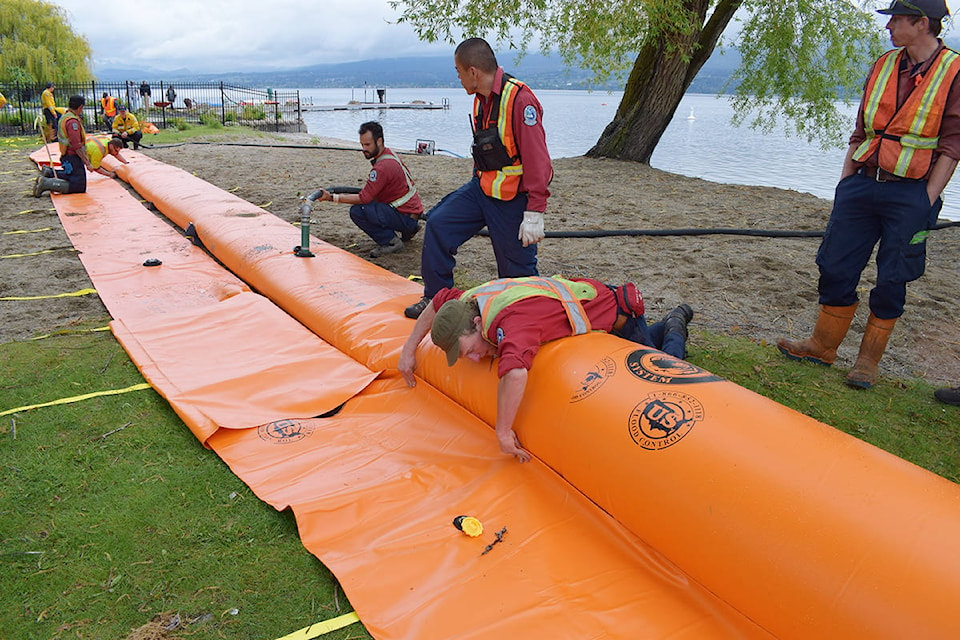With work ongoing to protect against flooding in the Central Okanagan as the level of Okanagan Lake rises, emergency response officials are calling on area residents to do their their part to help minimize damage from flooding.
Emergency Operations Centre public information officer Jason Luciw said that includes sandbagging properties in low-lying areas and near the lakeshore up to a level that will guard not only against typical flood water height, but 60 centimetres higher to protect against waves that could push more water onshore.
Along areas of the foreshore in West Kelowna Tuesday, crews installed mobile bladder dams—large plastic tubes filled with water—to keep the lake back from municipal property, civic infrastructure and residential areas.
Stakes were also visible in the ground with two markers. The lower marker is the 343-metre mark, said West Kelowna fire chief Jason Brolund, which if reached by lake water could mean the start of flooding. The higher mark is the 343.6-metre mark where officials say waves could reach.
Luciw said residents in those low-lying, lake-front areas should build sandbag walls at the upper height.
Also, anyone out on the lake with a boat is asked to reduce their speed so as not to cause wakes that could push more water onshore and worsen the affect of flooding as the lake level rises.
In one area, Pritchard Park, north of Gellatly Bay, an estimated 1,200 feet of bladder dam was being set up. A similar bladder dam was to be installed at Pebble Beach at the south end of Whitworth Road, later in the day.
West Kelowna officials are asking the public to stay away from the dams and not let children climb on them.
At Pritchard Park Tuesday, Brolund said that area is “ground zero” in terms of flood-prone area in the city.
Luciw said the placement of the bladder dams was decided based on a study of potential flooding areas, with the thought of protection of municipal infrastructure and residential property in mind.
Meanwhile, he said two large pumps are running “round the clock,” on the other side of the lake, near Kelowna General Hospital, pumping out the storm drain system there and working to lower the water table in the area.
He said emergency officials had been getting questions about KGH given its close proximity to the lake.
Luciw said the last time the level of Okanagan Lake rose this high— it is currently 342.7 metres—was in 1990, when it peaked at 342.86 metres. Flooding was reported then. The lake level has risen approximately three centimetres since Monday afternoon. It is now 22 centimetres above full pool.
The entire Central Okanagan area is still dealing with the affect of flooding that struck last week when several area creeks spilled over their banks. That was a result of heavy rains and warmer temperatures that melted snow at higher elevations. Now the concern is the rising level of Okanagan Lake, which those creeks feed into.
Stacey Harding, with the City of West Kelowna, said in addition to sandbagging at an appropriately high level to protest property, residents with docks should weigh them down in order to secure them in the event of higher water levels and the winds picking up. He suggested using containers that will hold large amounts of water, as they will provide more weight.
He recommended against using sandbags, as he said they would not provide enough weight. He also warned not to use lighter containers, such as canoes or kayaks filled with water, or children’s wading pools filled with water, because if the water levels rises significantly, they could float away.
For more information about how to protect your property, go to cordemergency.ca.
